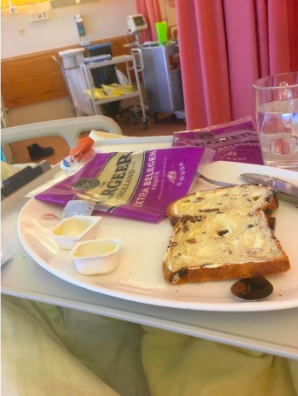Accession card
Description
This is breakfast at HMC Westeinde hospital in The Hague, the Netherlands. Every morning, the ‘breakfast cart’ comes along to each patient’s bedside, where the patient is offered a choice of white, wholegrain or raisin bread with butter, margarine, cheese or jam. Alternatively, patients can opt for a cereal (only one choice, an off-brand cornflake) with milk. Alongside this, you can choose to drink tea, coffee (both with or without milk, sugar and sweeteners) or apple or orange juice. You are also offered one hard-boiled egg. What interested me about my experience with Dutch hospital food is the variety from hospital to hospital. Due to my illness, I’ve spent significant times in different hospitals, eating different meals. HMC Westeinde has a lot of pre-packaged and processed food, as you can see in the picture here. The cheese slices are all individually packaged, which has a significant environmental toll. There is also no choice of fruit with breakfast, which struck me as surprising given that we are told from youth that fruit and vegetables are essential to our health. Moreover, there are no alternative cultural options. It is fairly well-known that many Asian and Slavic countries prefer savoury foods for breakfast. Given how multi-cultural the Hague is (being the political capital of the Netherlands and a hub for immigrant families), I expected there to be more choices in the types of dishes offered.
Contrastingly, as we can see in the second picture, is the menu in Ede Ziekenhuis, a hospital in the East of the Netherlands where I stayed for a week. This hospital has a programme whereby patients are in charge of their meals, and can order anything off the extensive (an entire page of A3!) menu, at any time – the hospital kitchen is open 24/7. This allows patients to take their dietary preferences and requirements into their own hands, and the results of the study Ede have conducted regarding the effects of this programme are considerable. Patients get out of hospital on average faster than when in hospitals that have no such programme, and report being happier and eating more than in other hospitals. They also tend to make healthier choices, as the menu is marked with different symbols (vegetarian, high fat, high protein, high sugar, low salt, high in minerals). Furthermore, one of the nurses on the ward told me that this programme encourages patients to continue making healthier eating choices once they are out of hospital, which has positive long-term impacts on their health.
It is fascinating to me that something as ‘mundane’ as eating – something we all need to do every day, and that many of us don’t put that much thought into – can have such an impact on one’s health. It was also interesting to compare the different accommodations to multi-cultural dietary preferences. Ede is in the Dutch ‘bible belt’, and has a majority Dutch and white population, more so than The Hague. Nonetheless, Ede still had many more multi-cultural choices than the hospital in The Hague did, offering dishes like roti and congee. When patients are offered food which is familiar to them and which they enjoy, they are more likely to eat it and thus advance their recovery sooner, as the body needs nutrients to heal after operations, injuries and medical interventions. I strongly believe that HMC Westeinde could learn a lot from the way Ede operates qua food.
By Avalon M. Leiman as part of the LUC project "Decolonising the Plate" led by Dr. Maja Vodopivec
Code
Date
University
Title
Medium
- Image



